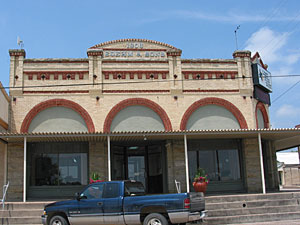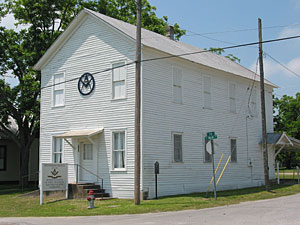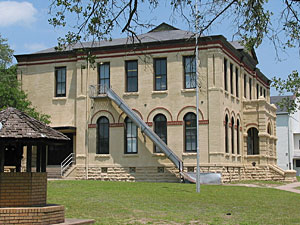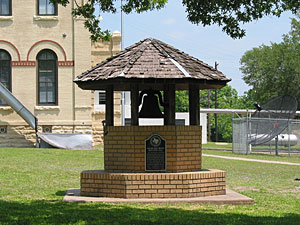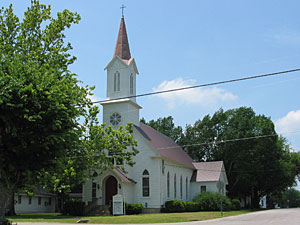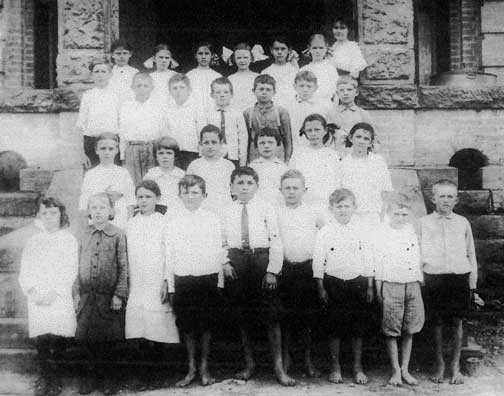From The Handbook of Texas Online:
Moulton is at the intersection of State Highway 95 and Farm roads 532 and 1680, on the Southern Pacific Railroad sixteen miles northwest of Halletsville in northwestern Lavaca County. It was founded in the mid-1850s two miles northwest of its present location. Some sources claim the town was named for a community in either Kentucky or Alabama; others contend that it was named for E. L. Moulton, a pioneer settler; and still others assert that it was named by a traveler who was reminded of his home by the live oak motts prevalent in the Moulton area. The Moulton post office opened in 1855. A private school was operated in a log cabin in the 1850s, and school was taught in an old Christian church in the 1860s. In 1874 M. H. Allis opened Moulton Male and Female Institute, which flourished until his death in 1892. The school had an excellent reputation in the county and assisted in the town's growth. In 1875 the community had several stores, a church, a wagon and blacksmith shop, and an Odd Fellows hall. In 1887 the San Antonio and Aransas Pass Railway built through the area two miles southeast of Moulton. A railroad station was constructed and given the name of Topeka. The old town gradually drifted to the station. Between 1888 and 1894 the post office in what became known as Old Moulton was renamed Moulton Institute, for the school. By the late 1890s the old site was pretty much abandoned, and the station community had taken the name Moulton. In the 1890s significant numbers of Czechs and Germans settled in the community, and by 1896 the town had an estimated 550 inhabitants, a Catholic church, a public school, a hotel, and cotton gins and gristmills. In 1900 the population reached 733, and in 1914 Moulton had Lutheran and Catholic churches, a bank, an opera house, telephone service, and a weekly paper, the Eagle. The town incorporated in 1940, when it had a population of 643 and sixty businesses. Moulton remained that size until the 1960s, when it began to grow, reaching a population of 968 in 1970 and 1,009 in 1980. Thereafter the town declined somewhat; in 1990 Moulton had 923 inhabitants and twenty businesses.
Historical Markers
Text from the historical marker erected in 1970 on Highway 95 at Nelson Street:
MOULTON
Founded (about 2 miles northwest) in early 1850s. Moved to this site after 1887 when the San Antonio and Aransas Pass Railroad extended its line from Yoakum to Waco, placing a station at this point. Sam and Will Moore, brothers, took lead in building an outstanding school here in 1901. Town remains an agricultural and shipping center.
Old Boehm StoreThis was site of first business in "New" Moulton, founded 1887 on advent of San Antonio and Aransas Pass Railroad. In the same year, Edward Boehm (1854-1920) built a frame store; enlarged it in 1897; and in 1906 rebuilt, using native stone. His sons Vladike and Edward, Jr., succeeded to ownership. 1971 |
|
Site of Moore HotelWilliam J. and Mary O'Daniel Moore moved to Texas from Alabama with their family in 1845, and settled in Lavaca County in 1853 on 500 acres. Moore was a farmer and raised livestock. Their son Samuel B. Moore also became a farmer and rancher. In the 1860s, Samuel and his brother William Moore bought 12,000 acres of land now lying between the towns of Moulton and Shiner. The Moore brothers granted right-of-way out of their land to the San Antonio and Aransas Pass Railroad in 1887. A townsite was platted, and the new town of Moulton was established. The Moore Hotel was built in 1888 to accommodate travelers. Constructed here east of the railroad depot, the 32-room hotel included a large room built for traveling salesmen to display their wares. The dining room and parlor in the hotel became a gathering place and the social center of the area. The Moore Hotel was sold to Christian Kotzbue in 1890. He added 10 more guest rooms and a wine cellar. The hotel was operated by the Kotzbue family for several decades, but gradually went out of business and was razed in 1940. A grocery store built in its place was converted into a cafe in 1942. [1996] |
|
Moulton Lodge No. 298, A.F. & A.M.First meeting held July 20, 1866. Chartered June 15, 1867, with 18 members. First building erected in cooperation with Live Oak Church, in 1874. Through the years, this Lodge has shared its building with other groups. It moved in 1894 to New Moulton. A new hall was built in 1910. [1969] |
|
Sam and Will Moore InstituteName honors brothers who gave site and half costs of building; the community matched their donation. Architect: H. Struve. Contractors: Joel Meyer & Co. Order of Sons of Hermann laid cornerstone July 31, 1901, in a gala celebration including a parade, band concert, barbecue, ball, and orations in English, German, and Czechoslovakian. North wing was added in 1923. Building still houses school. Recorded Texas Historic Landmark - 1973 |
|
Sam and Will Moore Institute BellAt institute's opening (1901), this bell rang the school day hours and soon became town's fire alarm. Its proudest day of civic use was November 11, 1918, when it sounded news of the armistice ending World War I. Discarded in 1939, it was restored in 1973. Incise on base: Erected by ex-students and friends. [1973] |
|
St. Joseph's Catholic ChurchOne of the oldest communities in Lavaca County, the town of Moulton was originally located about two miles from the current townsite. When the San Antonio and Aransas Pass Railroad completed a line through the area in 1887, the population shifted to the new location. Many German and Czech immigrants moved here and established family farms. When Moulton residents expressed a desire for a Catholic parish here, the Rev. John Forest of Hallettsville established St. Joseph's Church. A small frame sanctuary was built in 1888. Initially a mission of the Hallettsville Church, St. Joseph's became an independent parish in 1892. A parish school, operated by the Sisters of Divine Providence, was built in 1894. Destroyed by fire in 1902, it was replaced by a second facility. As the church continued to grow, additional buildings were erected on the property. Beginning in 1921, the Rev. Joseph Kopp (1879-1961) led the parish through thirty-eight years of growth and service. After seventy-one years of instruction, the parish school closed in 1965. Throughout its history, St. Joseph's Parish has been an important part of the Moulton community. [1988] |
|
Zion Lutheran ChurchCircuit-riding pastors served the religious needs of German Lutheran settlers of this area as early as the 1870s. A group of worshipers met to organize a congregation in March 1902. Land was purchased and construction of Zion Lutheran Church began in 1904. The church became the base for nearby rural churches. In 1927 members of the disbanded Immanuel Lutheran Church of Baursville joined the Moulton congregation. Often at the forefront of community activities, Zion Lutheran Church has been an important part of the area's history for many years. [1986] |
|
Orrin L. Winters CabinOriginally a two-room cabin, built about 1853 near the Lavaca River (2 miles northeast) by Orin L. Winters (1811-1902), a native of Tennessee. He lived in the structure until 1873. About 1902, the oak log cabin was torn down by Adam Schutz, and used to construct a barn and a blacksmith shop. The blacksmith shop later burned, and in 1973, the barn was dismantled, moved here, and restored as a cabin, to represent the pioneer heritage of Lavaca County. Incise on back: Donors: Building - The Adolph Petrek family Restoration and fence - William W. Allen, Mr. and Mrs. Alton C. Allen, Wilbur H. Baber, Jr. Marker - Descendants of Winters Family Site - City of Moulton Restoration contractor - Newton Peschel Recorded Texas Historic Landmark - 1974 |
|
Site of the Camp of the Texas ArmyMarch 15, 1836 under the command of General Sam Houston while retreating from Gonzales to the Brazos River. [1936 Centennial Marker] |
See Lavaca County Historical Markers page for other historical markers in the Moulton area.
Do you recognize anyone in this Moulton school group?
Photo contributed by Angelina Kretzchmar
Old Moulton
Text from the historical marker erected in 1970 two miles northwest of Moulton on FM 1680:
OLD MOULTON
At this point was center of original town of Moulton (named, according to tradition, by a man from Moulton, Alabama). First postmaster was James Walker (1856). Town gained statewide fame for the Moulton Institute operated 1874-1895 by Melvin H. Allis, M. A., and wife, Thankful ("Aunt Thank"). On the faculty was an outstanding teacher of music, Miss Sallie McLean. In 1887, San Antonio and Aransas Pass Railroad built its line two miles to the east, so town gradually moved there. Old Moulton Cemetery is one mile to the southeast.
Old Moulton Baptist ChurchOrganized 1873 by 25 former members of the Live Oak Church located near Nickel, Texas. Two-story structure built 1873-74; cornerstone laid January 31, 1874. Upper story used by Masonic Lodge until 1894; later served as schoolroom; removed about turn of century. Braces placed in structure after 1886 storm. Lower floor used continuously since 1874 as Baptist church. Congregation celebrated 75th anniversary on October 24, 1948. Recorded Texas Historic Landmark -- 1970 |
